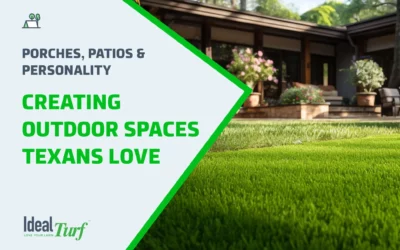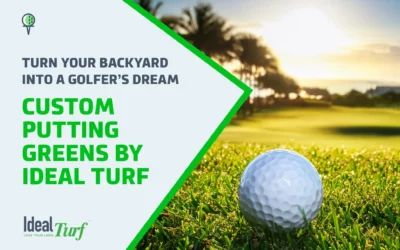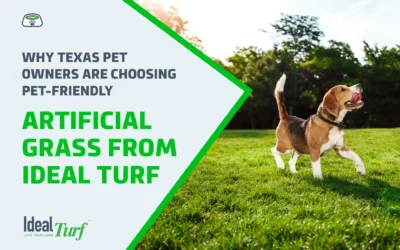Artificial Turf Innovations & Advancements: The Future of Synthetic Grass

Imagine a world where your lawn stays lush, green, and perfectly manicured all year round with minimal effort.
Thanks to recent advancements in artificial turf technology, this is no longer just a fantasy but a promising reality.
Artificial turf has long been transforming the way we perceive and utilize outdoor spaces.
This durable alternative to natural grass has evolved significantly over the years, offering unmatched versatility and durability.
Let’s delve into the exciting realm of synthetic grass and explore the recent innovations and advancements that are shaping the future of synthetic grass.

A Brief History of Artificial Turf
The history of artificial turf is a fascinating journey that spans over several decades, marked by innovation, experimentation, and continuous improvement. It all began in the mid-20th century when the need for a durable, all-weather playing surface prompted the development of synthetic grass.
The earliest form of artificial turf, known as “Astroturf,” emerged in the 1960s as a solution to the challenges of maintaining natural grass in indoor sports arenas. Astroturf was made from coarse nylon fibers, offering durability but lacking the natural look and feel of real grass. Despite its shortcomings, Astroturf quickly gained popularity, revolutionizing the sports industry by providing year-round playability and reducing maintenance costs.
Throughout the 1970s and 1980s, advancements in materials and manufacturing technology led to improvements in artificial turf. Polyethylene fibers were introduced, offering a softer and more realistic texture compared to nylon. Tufting and stitching techniques became more refined, resulting in a smoother and more uniform surface. These developments made artificial turf more aesthetically pleasing and comfortable, paving the way for its adoption in outdoor sports fields, recreational spaces, and even residential lawns.
The 1990s witnessed further evolution in artificial turf technology, with the introduction of infill materials such as rubber and sand. These infills provided enhanced shock absorption and stability, making artificial turf safer and more suitable for high-impact sports like football and soccer. Additionally, backing systems were redesigned to improve drainage and durability, ensuring optimal performance in various weather conditions.
In the 21st century, sustainability has become a key focus in the development of artificial turf. Manufacturers began incorporating recycled materials into turf components, reducing environmental impact and promoting eco-friendliness. Water-saving technologies and permeable backing systems were also introduced, making artificial turf more efficient and environmentally sustainable.
Applications of Modern Artificial Turf
The versatility of modern artificial turf extends beyond sports fields to encompass residential lawns, commercial spaces, and public areas. From backyard landscapes that remain lush and full year-round to vibrant green spaces in urban settings, synthetic grass offers a practical and visually appealing solution for various applications. Its adaptability and low maintenance requirements make it an attractive option for property owners seeking a sustainable and aesthetic landscaping alternative.
Comparison with Natural Grass
When evaluating artificial turf vs. natural grass, factors such as performance, maintenance requirements, environmental impact, and user preferences come into play. Natural grass holds cultural and aesthetic appeal for some.
Synthetic turf offers unmatched durability, year-round vibrancy, and eco-friendly benefits that appeal to a growing number of consumers and industry sectors. The ongoing debate between natural and artificial turf advocates underscores the importance of balancing tradition with innovation in landscape design and recreational planning.

Key Advantages of Artificial Turf
One of the primary attractions of artificial turf lies in its durability and low maintenance requirements. Unlike natural grass which necessitates regular watering, mowing, and fertilizing, synthetic turf offers a hassle-free solution that remains vibrant and uniform throughout the seasons.
Moreover, artificial turf presents a host of environmental benefits, including reduced water consumption and the elimination of harmful pesticides and fertilizers. This eco-friendly alternative contributes to a greener, more sustainable environment while saving resources and time for property owners.
In terms of cost-effectiveness, artificial turf proves to be a wise investment over time. While the initial installation costs may appear higher than sod or seed, the long-term savings on maintenance, water bills, and landscaping services often outweigh the upfront expenses, offering a compelling financial argument for choosing synthetic grass.

Recent Innovations in Artificial Turf
Recent advancements in synthetic grass technology have revolutionized the industry, paving the way for more durable, realistic, and high-performing artificial turf solutions. Recent innovations have set new standards for quality and longevity in artificial turf products.
Other innovations in artificial turf technology have elevated the playing field, quite literally. Advanced drainage systems mitigate water accumulation and enhance surface resilience, ensuring optimal performance even in inclement weather conditions. Additionally, cooling technology integrated into synthetic turf surfaces combats heat build-up, creating a comfortable and safe environment for players and spectators alike.
Furthermore, manufacturers have made significant strides in enhancing the aesthetics and tactile experience of artificial turf. Realistic textures and colors that mimic natural grass down to the last blade have revolutionized the visual appeal of synthetic lawns and sports fields, blurring the lines between reality and artificiality.
Enhanced Safety Features
Safety remains a paramount concern in the design and development of artificial turf solutions. Innovations such as shock-absorption technology and antimicrobial properties not only enhance player comfort and hygiene but also reduce the risk of injuries on sports and recreational surfaces.
These advancements underscore the commitment of industry leaders to prioritize user safety and well-being in every aspect of artificial turf construction. Below is a list of the features that have been incorporated into artificial turf systems in recent years:
- Antimicrobial Protection
- UV-Resistance
- Polyethylene Fibers
- Fully Permeable Backing
- Heat Resistance
- Static Block
Sustainability and Environmental Impact
While artificial turf offers a range of benefits, including water conservation and reduced maintenance costs, concerns about its environmental impact have been raised. It is crucial to assess the sustainability aspects of artificial turf manufacturing processes, disposal methods, and recyclability to ensure that synthetic grass remains a viable and eco-friendly option.
In an era marked by heightened environmental awareness, the sustainability of artificial turf plays a crucial role in its acceptance and continued growth. Manufacturers are increasingly implementing recycling initiatives to reduce waste and environmental impact.
Energy-efficient production methods and the reduction of water usage and chemical runoff further underscore the industries committment to eco-friendly practices. The industry is working toward aligning synthetic grass solutions with the principles of sustainable development.
Recyclable Synthetic Turf
Displosal of artificial turf at the end of the products life has been an issue for several years. Putting a sports field’s worth of artificial turf in a landfill doesn’t do the environment or turf industry any favors. As a result, biodegradable and recyclable artificial turf has been a goal of turf researchers and manufacturers.
SYNLawn, one of the leading artificial turf manufacturers here in the US is one of the companies leading these developments. They’ve introduced USDA certified turf products that are manufactured using Soy in place of plastics.
Future biodegradable synthetic grass will ensure that end-of-life disposal is no longer a burden on the environment. Until manufacturers create biodegradable turf, recyclable turf products will have to suffice.
The artificial turf industry has seen an increase in recycling initiatives. This keeps used artificial grass out of landfills. It also ensures that it’s processed and transformed into new, high-quality products. This closed-loop system reduces waste and conserves valuable resources, making it an ideal solution for eco-conscious consumers and businesses.
Water Conservation
In regions where water is scarce, keeping vibrant green lawns can be quite unsustainable. However, artificial grass is now becoming a popular and responsible choice due to advancements in water-saving technologies. Switching to eco-friendly artificial grass can enable an average household to save a substantial 22,000 gallons of water every year.
Artificial turf significantly cuts down on water usage. Moreover, with modern drainage systems in place, issues like waterlogging and soil erosion are minimized while creating healthier spaces for plants and wildlife.
The Synthetic Turf Council states that a large natural grass sports field spanning 1.32 acres can save a remarkable 500,000 to 1 million gallons of water annually (which is around 8.7 to 17.4 gallons per square foot).
Similarly, a smaller 1,800 square feet artificial turf lawn has the potential to conserve approximately 99,000 gallons of water each year. This translates to a substantial 70% reduction in a homeowner’s water expenses.

Challenges and Limitations
Despite its many advantages, artificial turf is not without its challenges. Issues such as heat retention in synthetic surfaces pose a concern, particularly in regions with high temperatures.
Longevity and recycling considerations also raise questions about the environmental sustainability of artificial turf solutions. Additionally, the maintenance requirements of synthetic grass demand careful attention to ensure longevity and optimal performance over time.
Consumer Perspective and Acceptance
The growing trend towards artificial turf adoption reflects shifting consumer preferences towards convenience, sustainability, and aesthetics. User experiences and reviews highlight the satisfaction of home and business owners with the performance and visual appeal of synthetic grass.
Factors such as water conservation, reduced maintenance costs, and year-round greenery contribute to the increasing acceptance of artificial turf in both residential and commercial settings.
Another area is that it can help attract more customers to your business and reduce the cost.
Economic Considerations for Artificial Turf
While the initial investment in artificial turf installation may surpass that of natural grass alternatives, the long-term economic benefits often justify the upfront costs. Savings on water bills, landscaping services, and maintenance expenses contribute to a compelling return on investment for property owners.
Furthermore, the economic impact of artificial turf extends to other industries. It’s driving growth and innovation in andscaping, sports facility management, and urban planning, to name a few.
The potential maintenance and water savings offered by synthetic grass are pretty enticing benefits. Advancements in artificial turf materials and manufacturing technologies will continue to drive down costs. Lower artificial turf costs will make it a more accessible landscaping option for home and business owners.
As consumers begin to see a quicker ROI from investing in artificial grass, it’s popularity will only increase.
Regulatory Standards and Guidelines
Ensuring quality and safety in artificial turf applications is paramount to industry stakeholders. Certifications, safety regulations, and compliance with environmental standards guide manufacturers and installers in maintaining high-quality standards and user safety.
Adhering to established guidelines fosters consumer trust and confidence in the reliability and performance of artificial turf products, reinforcing the industry’s commitment to excellence.

Future Prospects for Synthetic Grass
The future of artificial turf is marked by continued research and development aimed at enhancing performance, sustainability, and user experience. Predictions for upcoming innovations include advancements in materials, technologies, and design features that further elevate the standards of synthetic grass solutions.
With a focus on sustainable urban planning and environmental stewardship, artificial turf is poised to play a pivotal role in shaping greener, smarter, and more resilient cities of the future.
Looking ahead, the future of synthetic grass holds promise for even more groundbreaking innovations and advancements. From enhanced safety features for sports fields to customizable design options for landscaping projects, the evolution of artificial turf is geared towards meeting the evolving needs of customers while prioritizing sustainability and performance.
Technological Integration in Artificial Turf
The integration of technology into artificial turf goes beyond mere aesthetics and functionality. Smart turf systems equipped with IoT devices allow for real-time monitoring of surface conditions and automated maintenance routines.
The potential for future integration of AI-driven solutions holds promise for optimizing performance, resource efficiency, and user experience in artificial turf applications, paving the way for a new era of intelligent landscaping solutions.

Wrapping Up Our Guide to Artificial Turf Innovations
In conclusion, the landscape of artificial turf is evolving rapidly, driven by innovation, sustainability, and consumer demand.
Recent advancements in technology, safety features, and environmental practices are transforming synthetic grass into a viable and attractive solution for a diverse range of applications.
As the industry continues to push the boundaries of what is possible, the future of artificial turf looks promising.
A focus on performance, sustainability, and user experience will shape the landscape of tomorrow’s synthetic grass solutions.
If you have questions about infill or you’d like to discuss artificial turf for your home or business in Texas or Oklahoma, contact Ideal Turf.
To speak with our team simply click the “GET A QUOTE” button or feel free to give us a call at (800) 276-8587.

FAQ
How Has Artificial Turf Technology Evolved Over the Years?
Artificial turf technology has undergone significant advancements, leading to improvements in durability, realism, and sustainability.
Are There Eco-Friendly Options Available in the Artificial Turf Market?
Yes, manufacturers are increasingly focusing on developing eco-friendly artificial turf products that minimize environmental impact. SYNLawn is the most well-known company focused on producing sustainable turf products.
What Are the Main Benefits of Using Artificial Turf in Residential Settings?
Artificial turf in residential settings offers low maintenance requirements, year-round greenery, and enhanced aesthetic appeal. It’s also a pet-friendly ground cover, so you can have a prefect looking lawn and a dog. No need to worry about brown dog urine spots ruining the aesthetic of your yard.
How Does Artificial Turf Contribute to Water Conservation Efforts?
Artificial turf eliminates the need for extensive watering, helping conserve water resources and reduce overall water usage.
What Should I Consider When Choosing Artificial Turf for My Project?
Consumers should consider factors such as durability, appearance, maintenance requirements, and environmental impact when choosing artificial turf products.
Recent Posts
- How Synthetic Turf Helps Keep Fleas and Ticks Out of Your Texas and Oklahoma Yard
- Porches, Patios & Personality: Creating Outdoor Spaces Texans Love
- Turn Your Backyard into a Golfer’s Dream: Custom Putting Greens by Ideal Turf
- Why Texas Pet Owners Are Choosing Pet-Friendly Artificial Grass from Ideal Turf
- Why More Texans and Oklahomans Are Turning to Artificial Grass for a Greener Future





